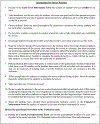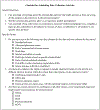Overcoming Challenges in School-Wide Survey Administration
- PMID: 28927306
- PMCID: PMC7927364
- DOI: 10.1177/1524839917733476
Overcoming Challenges in School-Wide Survey Administration
Abstract
School-based surveys provide a useful method for gathering data from youth. Existing literature offers many examples of data collection through school-based surveys, and a small subset of literature describes methodological approaches or general recommendations for health promotion professionals seeking to conduct school-based data collection. Much less is available on real-life logistical challenges (e.g., minimizing disruption in the school day) and corresponding solutions. In this article, we fill that literature gap by offering practical considerations for the administration of school-based surveys. The protocol and practical considerations outlined in the article are based on a survey conducted with 11,681 students from seven large, urban public high schools in the southeast United States. We outline our protocol for implementing a school-based survey that was conducted with all students school-wide, and we describe six types of key challenges faced in conducting the survey: consent procedures, scheduling, locating students within the schools, teacher failure to administer the survey, improper administration of the survey, and minimizing disruption. For each challenge, we offer our key lessons learned and associated recommendations for successfully implementing school-based surveys, and we provide relevant tools for practitioners planning to conduct their own surveys in schools.
Keywords: child/adolescent health; evaluation methods; school health; surveys.
Figures
Similar articles
-
Data collection procedures for school-based surveys among adolescents: the Youth in Europe Study.J Sch Health. 2013 Sep;83(9):662-7. doi: 10.1111/josh.12079. J Sch Health. 2013. PMID: 23879786
-
Student opinions of condom distribution at a Denver, Colorado, high school.J Sch Health. 1995 May;65(5):181-5. doi: 10.1111/j.1746-1561.1995.tb06226.x. J Sch Health. 1995. PMID: 7637335
-
Youth Risk Behavior Surveillance - United States, 2017.MMWR Surveill Summ. 2018 Jun 15;67(8):1-114. doi: 10.15585/mmwr.ss6708a1. MMWR Surveill Summ. 2018. PMID: 29902162 Free PMC article.
-
Increasing disclosure of school-related gender-based violence: lessons from a systematic review of data collection methods and existing survey research.BMC Public Health. 2023 May 30;23(1):1012. doi: 10.1186/s12889-023-15526-w. BMC Public Health. 2023. PMID: 37254071 Free PMC article.
-
Physical activity and the achievement gap among urban minority youth.J Sch Health. 2011 Oct;81(10):626-34. doi: 10.1111/j.1746-1561.2011.00637.x. J Sch Health. 2011. PMID: 21923875 Review.
Cited by
-
Methodological Considerations for Advancing Research on the Health and Wellbeing of Sexual and Gender Minority Youth.LGBT Health. 2019 May-Jun;6(4):156-165. doi: 10.1089/lgbt.2018.0141. LGBT Health. 2019. PMID: 31145662 Free PMC article.
-
Conducting tobacco control surveys among schoolchildren in Bangladesh, India and Pakistan: A feasibility study.PLOS Glob Public Health. 2024 Oct 3;4(10):e0003784. doi: 10.1371/journal.pgph.0003784. eCollection 2024. PLOS Glob Public Health. 2024. PMID: 39361632 Free PMC article.
References
-
- Brener ND, Eaton DK, Kann L, Grunbaum JA, Gross LA, Kyle TM, & Ross JG (2006). The association of survey setting and mode with self-reported health risk behaviors among high school students. Public Opinion Quarterly, 70(3), 354–374. doi:10.1093/poq/nf1003 - DOI
-
- Centers for Disease Control and Prevention (CDC). (2013). Methodology of the Youth Risk Behavior Surveillance System - 2013. Morbidity and Mortality Weekly Report, 62(1), 1–20. - PubMed
Publication types
MeSH terms
Grants and funding
LinkOut - more resources
Full Text Sources
Other Literature Sources
Miscellaneous



